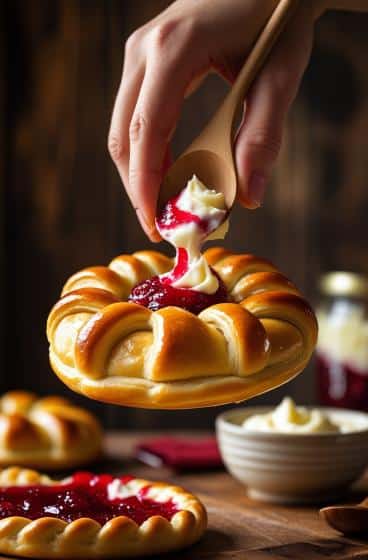The first time I bit into a fresh kolache, still warm from the oven, I had no clue I was about to fall into a lifelong obsession. There’s this way the pastry almost sighs in your mouth… soft, airy dough hugging a sweet or savory filling like it’s been waiting just for you. And honestly, I’m convinced the smell of a baking batch could bring a stubborn neighbor to your door faster than any invitation.
Kolache aren’t just another pastry. They’re a window into a rich culinary tradition, originally from Central Europe, with deep roots in Czech kitchens and immigrant bakeries in Texas. Sweet versions get most of the love—plush mounds of enriched dough cradling fruit preserves, poppy seed paste, or cream cheese. But if you’ve been around a Texas gas station, you’ll know the savory sausage-and-cheese kind too, even though purists might tell you those are technically “klobasniky.” Either way, they’ve got that same magic: dough that’s tender without collapsing, buttery without being greasy.
What makes kolache special? It’s the dough. Rich, eggy, a little sweet, and proofed just enough to be cloudlike without losing structure. There’s a science to it—one I’ll get into in a bit—and also a rhythm. The kind of thing you start on a slow morning and let rise while the sun’s still deciding what to do.
Ingredients & Substitutions
The best kolache dough is built on quality ingredients. This isn’t the place to skimp on butter or settle for margarine unless you truly must. Fresh milk, not long-life cartons, will give a richer flavor. And yes, you’ll want to weigh your flour if you can—precision matters more here than you’d think.
Here’s the full ingredient list for a basic sweet kolache dough with a cream cheese filling. You can swap fillings to suit your taste, but the dough stays mostly the same.
| Ingredient | Measurement | Notes & Substitutions |
|---|---|---|
| Whole milk | 240 ml (1 cup) | Warmed to 43°C / 110°F |
| Active dry yeast | 7 g (2 ¼ tsp) | Instant yeast works too—skip the proofing step |
| Granulated sugar | 50 g (¼ cup) | Can replace with honey for a floral note |
| Unsalted butter | 85 g (6 tbsp) | Softened, not melted |
| Large eggs | 2 | Room temperature |
| All-purpose flour | 420–450 g (3 ½ – 3 ¾ cups) | Bread flour will give more chew |
| Salt | 5 g (1 tsp) | Enhances flavor |
| Cream cheese | 225 g (8 oz) | Full-fat for best texture |
| Powdered sugar | 60 g (½ cup) | For the filling |
| Vanilla extract | 1 tsp | Optional, for filling |
| Fruit preserves | ~120 g (½ cup) | Any flavor, not too runny |
A few quick ingredient insights:
Use whole milk. The fat keeps the crumb tender. Skim milk will make the dough less rich, and trust me, you’ll notice. If you swap all-purpose for bread flour, your kolache will have a bit more bite, which works well for savory fillings. And don’t even think about skipping the egg—without it, the dough will lose that golden color and softness.
Step-by-Step Instructions
Step 1 – Activate the yeast
Warm the milk to just about body temperature—too hot and you’ll kill the yeast, too cold and you’ll be staring at a bowl of sad liquid. Stir in the yeast and a pinch of sugar. Wait 5–10 minutes until it’s foamy like a cappuccino. If nothing happens, your yeast is dead, and it’s better to find out now than after kneading.
Step 2 – Mix the dough
In a large bowl, beat the butter and sugar together just until combined. Add the eggs one at a time, mixing well. Pour in the milk-yeast mixture. Add flour gradually, mixing until a soft dough forms. You’re aiming for something tacky but not so sticky it clings to your soul.
Step 3 – Knead
Turn the dough onto a floured surface and knead for 8–10 minutes. Or use a stand mixer with a dough hook—let it do the work while you sip coffee. You want a smooth, elastic dough that bounces back when poked. Don’t rush; gluten needs time to develop here.
Step 4 – First rise
Place the dough in a lightly greased bowl, cover with a damp towel, and let it rise in a warm spot until doubled in size—about 1 to 1 ½ hours. Resist the urge to poke it every 5 minutes. Temperature matters here; too cold and it will crawl, too hot and you’ll risk overproofing.
Step 5 – Prepare the filling
While the dough rises, beat cream cheese, powdered sugar, and vanilla until smooth. Keep fruit preserves ready but avoid watery jams—they’ll seep into the dough and make soggy bottoms.
Step 6 – Shape
Punch down the dough (gently, you’re not starting a bar fight). Divide into pieces about 50–60 g each. Roll into smooth balls. Arrange on a lined baking sheet, cover, and let rest for 15 minutes—this makes them easier to shape without springing back.
Step 7 – Make wells and fill
Using your fingers or the bottom of a small glass, press deep wells in the center of each dough ball. Spoon in about 1 tablespoon of cream cheese filling, then top with a small dollop of preserves.
Step 8 – Final proof
Cover and let rise another 20–30 minutes. This last proof gives them their final puff before baking.
Step 9 – Bake
Preheat oven to 190°C (375°F). Bake kolache for 12–15 minutes, until lightly golden. You’re not going for dark brown here—just enough color to signal the butter’s done its job.
Step 10 – Cool and serve
Let them cool slightly before eating. Warm is best, but piping hot will burn your tongue and make you curse in three languages.
Common mistakes to dodge:
– Using too much flour, which leads to dense kolache.
– Overfilling with jam, causing overflow.
– Skipping the final proof, resulting in flat pastries.
Cooking Techniques & Science
Kolache dough works because of balance. The sugar doesn’t just sweeten—it feeds the yeast, encouraging a strong rise. Eggs enrich the dough and add structure. Butter coats some flour proteins, slowing gluten development just enough to keep the crumb tender.
The double proofing is essential. The first rise develops gluten and flavor, the second relaxes the dough so it bakes without tearing. That’s why you can’t rush this with too much yeast—it’ll puff too fast and then collapse in the oven.
From a texture standpoint, the milk proteins create a softer crust than water would. This is why milk-based doughs like brioche and challah share a similar tenderness.
Storage: Store kolache in an airtight container at room temp for up to 2 days. Refrigeration makes them stale faster, so avoid unless filled with meat or cheese. For longer storage, freeze after cooling, wrapped tightly. Reheat in a 150°C (300°F) oven for 8–10 minutes.
Variations & Substitutions:
– Savory kolache: Swap fruit for cooked sausage, cheese, or scrambled eggs.
– Vegan: Use plant milk, vegan butter, and flax eggs (1 tbsp flaxseed meal + 3 tbsp water per egg).
– Gluten-free: Use a 1:1 GF flour blend with added xanthan gum, but expect a denser result.
Tools that matter:
A stand mixer is your best friend for kneading enriched dough. A kitchen scale ensures accuracy—volume measurements for flour can swing wildly. And a silicone baking mat keeps bottoms from overbrowning.
Serving & Pairing Suggestions
Sweet kolache pair beautifully with black coffee or milky tea. Savory ones work as breakfast-on-the-go with fresh fruit or a simple salad. For presentation, dust sweet ones with powdered sugar just before serving—it hides any filling bubbles and makes them look bakery-perfect.
If you’re making them for a brunch spread, arrange different fillings on one tray for visual appeal: apricot, blueberry, poppy seed, cream cheese. It’s a low-effort way to make them look like a pastry shop selection.
Best Time to Serve
Morning is classic—fresh kolache are the kind of thing that make people linger over coffee. But they also shine as an afternoon pick-me-up. In Texas, they’re a road trip staple, so don’t be afraid to bake a batch the night before and pack them for travel.
Conclusion
Kolache aren’t difficult, but they do demand care. The joy is in the details—the gentle proofing, the way the dough shapes under your hands, the smell filling your kitchen before you’ve even taken them out of the oven. They’re proof (pun fully intended) that simple ingredients, treated with respect, can become something extraordinary.
Once you’ve mastered the dough, the filling possibilities are endless. Sweet, savory, seasonal—each one tells a little story. And maybe, just maybe, you’ll find yourself baking them not just for breakfast, but for the sheer comfort of it.
FAQs
1. Can I make the dough ahead of time?
Yes. You can refrigerate it after the first rise for up to 24 hours. Let it come to room temp before shaping.
2. Why did my kolache turn out dense?
Likely too much flour or underproofing. Enriched dough needs careful handling to stay light.
3. Can I use store-bought jam for filling?
Absolutely, but choose thick, high-quality preserves to prevent sogginess.
4. How do I keep the filling from leaking?
Avoid overfilling and use thicker fillings. Chilling the dough slightly before baking can also help.
5. Can I make mini kolache for parties?
Yes—use 25–30 g dough balls and reduce baking time to about 8–10 minutes.
If you want, I can also give you a professional baker’s overnight kolache method that makes the dough even softer and improves flavor. That would make this guide even more pro-level. Would you like me to add that?

